- Submissions

Full Text
Forensic Science & Addiction Research
Stature Reconstruction from Handprint Dimensions in an Adult Nigerian Student Population
Nandi Michael Ebe*, Ibeabuchi Nwachukwu Mike, Olabiyi Olaleye A, Okubike Emeka Ambrose and Iheaza Euphemia Cyprian
Department of Anatomy, University of Lagos, Nigeria
*Corresponding author: Nandi Michael Ebe, Department of Anatomy, College of Medicine, University of Lagos, Nigeria
Submission: February 16, 2018; Published: March 19, 2018

ISSN: 2578-0042 Volume3 Issue1
Abstract
Background: On regular basis, crimes are committed and the perpetrators of such offences roam the streets unidentified because of insufficient evidence to connect the suspect to the crime. Therefore handprints hold a cardinal role in linking offenders to crimes and its correlation to stature cannot be undermined as it widens the prospect and precision of human identification in medico-legal investigations.
Objective: The objective of the current study is to derive regression models that will predict stature from hand prints parameters amongst Nigerian adults.
Subjects and method: This cross-sectional research comprises of a total sample size of 230(100 males and 130 females) healthy adult Nigerians, aged between 18 to 36 years. This study employed direct and indirect method to acquire handprints dimensions (Handprint Length, Breadth, palm print length and digit length of left and right hand) following standard procedures. The data derived were subjected to series of statistical analysis using Statistical Package for Social Sciences (SPSS version 20 Chicago Inc) including descriptive statistics, independent and paired sample t-test, Pearson moment correlation coefficient and Durbin Watson regression.
Results: The present results for stature records 176.36±8.13cm and 164.38±6.62 for males and females sample respectively. Values of handprints dimension showed a range of positive Pearson moment correlation coefficient (r) of 0.31 to 0.73 which represent weak to strong r value. The regressions formulas derive were observed to be more reliable in multiple linear regression equations when reconstructing stature than single linear equation due to different levels of standard error of estimates (SEE) and coefficient of determination (R2) using>99% accurate estimation rate of the equations.
Conclusion: The regression models derived can effectively reconstruct stature which may be useful to a forensic expert saddled with the task of human identification among disaster victims or crime scene.
Keywords: Forensic sciences; Handprints; Stature reconstruction; Human identification; Adult Nigerians
Introduction
Unravelling the identity of an individual death or alive from stature is a mainstay in forensic practice and it is still of societal interest. With the rate of mass disasters, either natural or man- made like flooding, earthquakes, traffic accidents war, acts of terrorism and homicides becoming on high side, it is common to find dismembered human remains and peripheral parts of the body [1,2]. Also with recent advances in technology, the role of a forensic anthropologist has evolved to include not only the study of skeletal remains, but in an era of global migration (both legal and illegal), and incidences of the aforementioned crimes and natural disasters required the analysis of living individuals or body parts [3].
Relationships that exist between different parts of body and height have been of great interest to forensic anthropologists and medical scientists for many years [4]. This is because of the increase in the number of crimes and mass death from natural and man-made disasters which usually requires the identification of victims from dismembered remains or arrest defaulters of the law for justice to prevail [5].
Several approaches have been made by different researcher to study human variation from various subfields of physical anthropology, depending on their research interest, training and life experiences. Typically, a forensic anthropologist concentrates more on the practical use of human variation towards determining a biological profile of unrecognized identities, mainly to narrow down the pool of possible identities [6]. As one of the cardinal indexes in formulating biological profile, Stature reconstruction is still a key element that can provide useful data towards narrowing the pool of potentially matching identities [3,6]. Human stature is one of the prime physical attributes employed in ascertaining the identification of such unknown mutilated deceased bodies found in crime sites [7]. Also stature is a fundamental human characteristic to assess growth and nutrition, for calculating body surface area and helps in disaster victim's identification [8]. The role of Handprints in forensic sciences as it concerns human identification cannot be overemphasized, because often than non assassination occur and sometimes the assassin choose to strangle the victim without gloves or handprints seen on door handles or guns left at crime scenes can help the investigator to trace down the identity of the person first by estimating stature which is vital but inexpensive tool.
The development of height is a very sensitive trait, depending on a number of factors such as sex, age, race, body composition, socio-economical status and secular happenings. The proportions of its particular components (extremities, trunk) also reveal great variability [9]. For this reason, the application of the best and one specific formula to a particular population for other groups is very difficult and unaccepted as different regions posses their peculiar characteristics [9-11].
In developing countries like Nigeria where this study was carried out, stature reconstruction from handprints dimensions has received little attention and still unexplored despite the significance of stature in human identification. There is still limited biometric data on handprints of Nigerians which aid in human identification. Although recent literature have demonstrated that anthropometry of the handprints has considerable promise for the accurate and reliable reconstruction of stature; but the technique has only been tested in a relatively limited range of populations [11,12].
Therefore it is very imperative for alternative methods of formulating models that can serve as a benchmark in forensic science. Thus, the present study was an attempt to design and set up a forensic database that can predict stature of Nigerian adults from handprints dimensions.
Subjects and Method
Study design
This study was carried out among undergraduates and postgraduates medical students of Nigeria origin in the University of Lagos, Nigeria. The study cohort comprises of 230 (100 males and 130 females), who fall within age group of 18 to 36 years, participants invited for this research were healthy students without any form of obvious congenital standing inability like Scoliosis, Kyphosis or hand dermatoglyphic impairment. Measurements were taken by one investigator to avoid inter-observer bias error and data acquisition took place at a fixed time to avoid diurnal variations.
Materials used
Seca Stadiometer calibrated in cm (Figure 1), Constructed ink pad (Figure 2), white plane papers A4 size (Figure 3), thumb tags to provide a firm grip on the plane shit (Figure 4), pencil, and meter rule calibrated in cm, square wooden plank.
Data Acquisition
Stature measurement
Measurement of stretch stature was taken with Seca stadiometer as the height of the person between the vertex and the floor of a bare footed participant.
Protocol
With the heels together and arms adducted, the subject was made to stretch upwards to the fullest extent during inhalation. Once the head is held in the Frankfurt plane, the movable piece of anthropometer was then made in contact with the vertex in the mid-sagittal plane (Figure 1).
Figure 1: (Seca Stadiometer calibrated in cm.)

Handprint Protocols
The handprint data acquisition method employed from this study was in line with other standard anthropometric protocols carried out by other researchers [9-11].
Protocol
The indelible endorsing ink was poured on a constructed ink- pad; the hands of the participant were gently pressed against the ink pad and then placed with a little pressure on the A4 sized white paper to make an outline of handprints. The paper is allowed to dry after which anatomical landmarks drawn using HB pencil followed by measurements using a meter rule calibrated in centimetres (Figure 2-4).
Figure 2: Constructed ink pad.
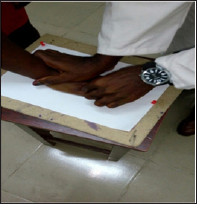
Figure 3: white plane papers A4 size.

Figure 4: Thumb tags to provide a firm grip on the plane shit.

Handprint length (HPL)
HPL was taken as the distance between the mid-points of the distal transverse crease of the wrist to the most anterior projection of the skin of the middle finger (dactylion).
Protocol: Haven marked the mid-stylion crease and the tip of the middle finger from the hand impression on the white paper, a line was drawn using pencil joining the two landmarks and readings were taken using meter rule in cm (Figure 4).
Palmprint length (PPL)
PPL was measured as the distance from the mid-point of the distal transverse (Mid-stylion) crease of the wrist to the proximal flexion crease of the middle finger.
Protocol: The inter-stylion or mid-stylion crease was marked as well as the proximal crease of the middle finger and a meter rule calibrated in centimeters was placed to take measurement (Figure 4).
Handprint breadth (HPB)
HPB was measured as the distance from the most laterally projected part of the palm print at the 2nd metacarpal to the most medially projected part of the palm print at the distal transverse crease.
Protocol: with the use of a pencil and meter rule, a line was drawn from the 2nd metacarpal (metacarpomediale) to the 4th metacarpal (metacarpolaterale) as shown in Figure 4.
Print digits length
The digit length (Index (2PDL); Middle (3PDL); Ring (4PDL) and Little Finger (5PDL) length) was measured as the distance between the proximal flexion creases of the finger to the tip (dactylion) of the respective fingers (Figure 4).
Protocol: The anatomical landmarks were marked and a straight line drawn from the proximal flexion crease to the tip (dactylion) of the respective fingers, with the use of a meter rule readings were taken to the nearest 0.01cm (Figure 4).
Statistical Analysis
The data acquired were subjected to series of analyzed using Statistical Package for Social Sciences (SPSS) software version 20, Chicago Inc. for Descriptive statistics was employed and presented as Mean±SD, Independent and paired sample t-test were equally engaged to ascertain sexual dimorphism at (p<0.01), Pearson moment correlation coefficients (r) were analyzed to ascertain the association between handprints parameters and stature, Simple regression formulas were derived using MS word excel window 7, was used to analyze Scatter plots, and Durbin Watson, enter method and step-wise method were respectively used derive multiple regression models to reconstruct stature using SPSS.
Results
Table 1 & 2: Showed results of descriptive statistics and independent sample student t-test for males and females' stature and handprints dimensions presented as mean plus or minus standard deviation (Mean±SD). The average value for adult Nigerian stature recorded 176.36±8.13cm and 164.38±6.62cm for males and females respectively (Table 1). While the results of descriptive statistics for hand and digits print length are presented in Table 1 & 2. Results of the independent sample student t-test are indicated alongside the mean values as well as range at (p<0.01) shows statistically significant difference between males and females. Sexual dimorphism (p<0.01) was statistically proven and recorded across all studied parameters with higher values consistently observed in males than females both in left and right hand print dimensions.
Table 3: Summarizes results of Pearson moment correlation coefficient (r) between stature and handprint dimensions in male and female adult Nigerians. This results record a range of correlation coefficient of 0.31 to 0.72 with the highest and strongest correlation (r) observed between stature and female's handprint length while the lowest and weakest correlation value was seen between stature and males left handprint breadth. Generally females' r values showed better correlation than males across all the studied variables.
Table 4: Presents results of Pearson's moment correlation coefficients (r) between handprint digits length and stretch stature in the male and female samples. It was observed that there were no consistent stronger and higher values in correlation coefficient of left and right handprint digits length but the results showed that females exhibited higher and stronger association with stature than males in all the parameters. The range had r=0.35 to 0.61 for males fifth digit print length (5DPL) and Females third and fourth digit print length (4DPL) representing weakest and strongest correlation coefficient respectively.
Table 5: Summarizes multiple linear regression formulas for the males and females participants for left and right sides of handprint dimensions.
Table 1: Summary of descriptive statistics of handprints dimensions (cm) of right and left hand sides in males and females sample.

Values with similar Superscriptaa shows results of independent sample t-test statistically. Significant bilateral asymmetry between left and right handprint dimensions.
Table 2: Descriptive statistics of handprints digit length (cm) of right and left in males and females.

Values with similar Superscriptbb are statistically significant different at P<0.01 between males and females digit print dimension.
Table 3: Pearson moment correlation coefficient (r) between stature and handprints dimensions in males, females and combined sample population.

Values with asterisk ** Pearson Moment Correlation (r) is Statically positive significant at p<0.01.
Table 4: Correlation coefficient (r) between stature and handprint digits length of left and right side measurements in males, female and combined sample population.

Values with similar superscript CC Pearson Moment Correlation (r) is statically significant at p<0.01.
Table 5: Multiple linear regression models for stature reconstruction using anthropometric parameters of right and left handprints in male and female.
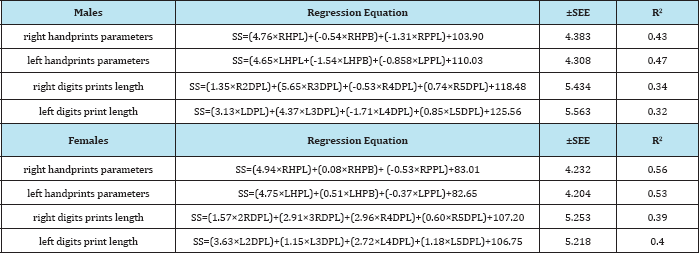
Key: RHPL= Right Hand Print Length; RHPB=Right Palm Print Length; RPPL=Right Hand Breadth; LHPL= Left Hand Print Length; LHPB= Left Hand Print Breadth; LPPL=Left Palm Print Length; R2DPL=Right Second Digit Print Length; R3DPL=Right Third Digit Print Length; R4DPL=Right Fourth Digit Print Lengh; R5DPL=Right Fifth Digit Print Length; L2DPL=Left Second Digit Print Length; L3DPL=Left Third Digit Print Length; L4DPL=Left Fourth Digit Print Length; L5DPL=Left Fifth Digit Print Length for Males and Females.
Stature reconstruction regression equations were derived using the Durbin Watson regression formula as follow: Y=a+bX.
Where, Y is the dependent variable (Stature) and X represents the independent variables (Left and right handprint and digits length). "a" and "b," represents the regression coefficients of Y and X respectively. Here it was observed that the multiple linear regression models show high level of reliability and precision in determining statue from handprint dimension. With low values of standard error of estimate (SEE) and high values for coefficient of determination (R2) showed that multiple regression equations have more accuracy when reconstructing stature compared to single regression formulas derived from this study.
Graph 1: Scattered plots of stretched stature (SS) (cm) vs right handprint length (RHPL), right handprint breadth (RHPB) and right palm print length (RPPL) with simple linear regression equation and coefficient of determinations (R2) in Males.

Graph 2: Scattered Plots of Stretched Stature (SS) in cm vs left handprint Length (LHPL), left handprint breadth (LHPB) and right Palmprint Length (RPPL) with simple linear regression equation and coefficient of determinations (R2) in Males.

Graph 3: Scattered plots of stretched stature (SS) in cm vs right handprint length (RHPL), right handprint breadth (RHPB) and right palm print length (RPPL) with simple linear regression equation and coefficient of determinations (R2) in Females.
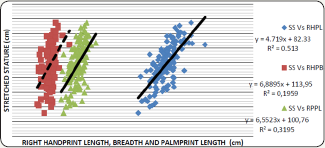
Graph 4: Scattered plots of stretched stature (SS) vs left handprint length (LHPL), right handprint breadth (LHPB) and Palmprint Length (LPPL) with simple linear regression equation and coefficient of determinations (R2) in Females.
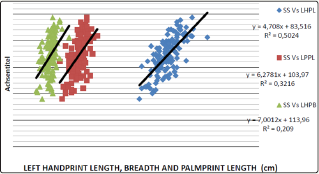
Graph 5: Scattered plots of stretched stature (SS) vs right print digits length of: second digits print length (R2DPL), Third digit print length (R3DPL), Fourth digit print length (R4DPL) and fifth digit print length (R5DPL) with simple linear regression equation and coefficient of determinations (R2) in males.

Graph 6: Scattered plots of stretched stature (SS) vs left print digits length of: second digits print length (L2DPL), third digit print length (L3DPL), fourth digit print length (L4DPL) and fifth digit print length (L5DPL) with simple linear regression equation and coefficient of determinations (R2) in males.
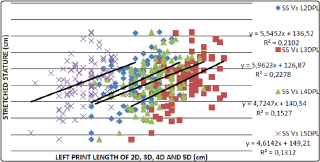
Graph 7: Scattered plots of stretched stature (SS) vs right print digits length of: second digits print length (R2DPL), third digit print length (R3DPL), fourth digit print length (R4DPL) and fifth digit print length (R5DPL) with simple linear regression equation and coefficient of determinations (R2) in females.
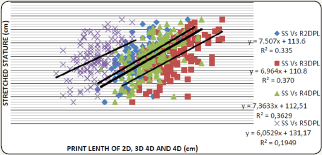
Graph 8: Scattered plots of stretched stature (SS) vs left print digits length of: second digits print length (L2DPL), third digit print length (L3DPL), fourth digit print length (L4DPL) and fifth digit print length (L5DPL) with simple linear regression equation and coefficient of determinations (R2) in females.

Graph 1-8: Summarizes Scatter plots and simple regression lines showing different significant (P<0.01) positive correlation and coefficient of determination (R2) between stature and handprint digit length in both gender, left and right hand sides (n=230). Simple linear regression equations are derived and presented in the respective graphs with varying coeffiecient of determination or reliability (R2). The accuracy of each regression equation formulated from the scatter plots were observed and determine by the R2 value, because it was observed that the higher the R2 value the more accurate the regression line is. Thus, R2 values correspond and are directly proportional to r value.
Discussion
Stature reconstruction is a commonly used method in forensic identification analysis. The remnants and evidences available at crime scene or catastrophes can provide adequate information concerning the biological profiles of unknown persons [12].
Results of Handprints dimensions for descriptive statistics documented in Table 1 & 2, presents mean and range (maximum- minimum) values of stretch stature, handprints length (HPL), handprints breadth (HPB) palm prints length (PPL) for both gender and left and right limb (Table 1) and handprints digits length for Second print digit length (2DPL), third digit prints length (3DPL), Fourth handprints digit length (4DPL) and Fifth digit length presented in Table 2 for left and right digit prints dimensions. Results of independent sample t-test were presented alongside the descriptive statistic to evaluate gender differences in handprint dimensions. Sexual dimorphism was observed with higher values consistently recorded in male cases than their female counterpart in all the measured parameters for both left and right hand sides (Table 1 & 2). This results did not record exact values for left and right hand sides but when subjected to paired sample t-test, bilateral handprints asymmetry were not statistically significant which contradict the findings of Ishak et al. [3], Krishan et al. [9] and Kornieieva & Elelemi [12] on handprints variables which reported significant statistical (p<0.05) difference between left and right handprint values in both sexes. Thus, Kornieieva & Elelemi [12] further proposed that hand dominance plays a vital role in bilateral limb asymmetry.
The present study document the correlation coefficient (r) which portrays the relationship between stature and handprints and digit length (Table 3 & 4 and Graph 1-8). The lowest and weakest Pearson correlation (r) value was recorded in males handprint breadth while strongest relationship was observed in females hand prints length with r=0.31 and 0.72 respectively for the range (Table 3 & 4). The correlation of stature with digits prints length record a minimum relationship of r=0.35 in males fifth digit length and maximum value of r=0.61 in females third and fourth digit length respectively (Table 4). Generally the female's values consistently showed stronger association with stature than the result of males sample in all the studied variables as seen in Table 3 & 4 which is not in tandem with the report of Ishak et al. [3] in a Western Australian population, which record irregular stronger correlation coefficient with stature in males and females. Although bilateral limb asymmetry also influenced the relationship with stature when predicting because different sides of the limbs will correlate differently thereby formulating contrasting equations in one individual which may not give accurate results whenever the results of both side are compared [13].
The findings of Ishak et al. [3] in a Western Australian Population had Pearson correlation coefficient for handprint length, breadth, Palmprint length as r=0.64, 0.57 and 0.58 for males left handprint, r=0.64,0.57 and 0.57 for males right handprint dimensions. While the female values include handprints r= 0.65, 0.47 and 0.64 for left handprints length, breadth and palm length and right handprints dimensions recorded r =0.65, 0.50 and 0.62 respectively, with positive correlation with stature statistically significant (P<0.05) which is similar to that of the present study (Table 3 & 4 and Graph 1-8). But their regression formulas derived were specific and peculiar to only the Western Australian populace because the equations of their parameters both simple linear and multiple linear equations recorded a contrasting standard error of estimate (SEE) ranging between ±4.74 to 6.53cm higher than the present SEE value that record a range of ±4.204 to 5.563cm (Table 5).
The current research recorded lower SEE in handprints dimensions in females than males (Table 5), this correspond with the values of the coefficient of determination (R2) seen in Table 5 for multiple equations and Graphs 1-8 for simple equations which conforms with the data of Krishan et al. [9] among Panjab Medical students in India, the work of Sangeeta et al. [11] on Rajasthan population, that of Paulis [13] in an Egyptian population and that of Kornieieva & Elelemi [12] in a Sample of Saudi Population which all reconstructed Stature from Handprints parameters and found contrasting values for Pearson correlation coefficient (r), coefficient of determination (R2) and standard error of estimate (SEE) between stature and handprint parameters which is a pointer that no two populations have the same values for body parameters. These variations further buttress the fact that every region needs a population-specific regression equation for prediction of stature. The coefficient of determination which is directly proportional to the Pearson correlation coefficient and inversely proportional to SEE, conforms to other previous studies since the higher the R2 value, the more accurate and reliable the prediction model will be (Table 5 and Graphs 1-8).
Conclusion
Stature reconstruction from handprints dimensions is of great relevance to forensic practitioners. The current research observed strong association between stature and handprints variables. A total of twenty eight simple and eight multiple regression formulas were derived from this research which can be reliably used to predict stature from handprints measurements in an adult Nigerian population. When compared, there was no statistically significant difference between measured and reconstructed stature from handprints variables. The derived formulas can only be applicable in an adult Nigerian population; so the use of these equations by other ethnic groups or region will warrant a falls results. It is believed that these equations will be useful to a forensic expert in medico-legal practice in solving crime issues and identifying humans involved in catastrophic occurrences. Thus, it is recommended that further works be done in other age groups in Nigeria and other climes.
Acknowledgement
The authors wish to express their profound gratitude to the study participants who out of their tight schedules created time to undergo this time consuming data acquisition exercise.
Ethical Approval
For this research work to kick off, a letter of ethical clearance was communicated via a memo: CM/HREC/12/16/083 to the research team through the principal investigator haven met all the prescribed criteria by Health research and Ethics Committee of the College of Medicine, University of Lagos (CMUL) concerning human and animal experiment.
Informed Consent
All participants were mandated to sign an informed consent form in duplicate. Prior to the signing, the study procedures, measurement, purpose for the research and possible personal benefits were explained to the participants through information contained in the official informed consent form. Then all questions not covered in the document were orally. Only after a clear indication of full understanding, readiness and acceptance to participate were research participants enrolled in the study. All participants received a guarantee of respect and preservation of their personal space, anonymity during and after data collection, and their right to withdraw if so desired at any stage for whatsoever reason.
References
- Ahemad N, Purkait R (2011) Estimation of stature from hand impression: a nonconventional approach. Journal of Forensic Science 56(3): 706709.
- Khaled EA, Soheir AM, Maha AH, Eman AM (2011) Determination of sex from hand dimensions and index/ring finger length ratio in Upper Egyptians. Egyptian J Forensic Sci 1(2): 80-86.
- Ishak NI, Hemy N, Franklin D (2012) Estimation of stature from hand and handprint dimensions in a Western Australian population. Forensic Sci Int J 216(1-3): 199.e1-e7.
- Banik SD, Azcorra H, Valentin G, Bogin B, Dickson F (2012) Estimation of stature from upper arm length in Children aged 4.0 to 6.92y in Merida, Yacatan. Indian J of Pediatrics 79(5): 640-646.
- Hossain S, Begum, JA, Akhter Z (2011) Measurement of stature from arm-span-an anthropometric study on garo tribal bangladeshi females. Bangladesh J of Anat 9(1): 5-9.
- Ishak NI (2010) Sex and stature estimation using hand and handprints measurement in a Western Australian population. Centre for forensic science and University of western Australian 2010: 1-170.
- Kachan T, Krishan K (2011) Anthropometry of hand in sex determination of dismembered remains-a review of literature. J of Forensic and Leg Med 18(1): 14-17.
- Oria RS, Igiri AO, Egwu OA, Nandi ME (2016) Prediction of stature from hand length and breadth-anthropometric study on an adult Cross River State population. Annals of Bioanthropol 4(1): 12-16.
- Krishan K, Kanchan T, Kharosha MA (2015) Estimation of stature from handprint dimensions-positional variations in real crime scene situations. Egyptian J of Forensic Sci 5(4): 129-131.
- Kanchan T, Rastogi P (2009) Sex determination from hand dimensions of North and South Indians. J of Forensic Sci 54(3): 546-550.
- Sangeeta D, Choudhary V, Kapoor AK (2015) Stature estimation from handprints: A study in Rajasthan. Int J of Advance Res and Scientific Tech 4(5): 472-475.
- Kornieieva M, Elelemi AH (2016) Estimation of stature from hand measurements and handprints in a sample of Saudi population. Arab J Forensic Sci & Forensic Med 1(3): 289-298.
- Paulis MG (2015) Estimation of stature from handprint dimensions in Egyptian population. J Forensic Leg Med 34: 55-61.
© 2018 Nandi Michael Ebe, et al. This is an open access article distributed under the terms of the Creative Commons Attribution License , which permits unrestricted use, distribution, and build upon your work non-commercially.
 a Creative Commons Attribution 4.0 International License. Based on a work at www.crimsonpublishers.com.
Best viewed in
a Creative Commons Attribution 4.0 International License. Based on a work at www.crimsonpublishers.com.
Best viewed in 







.jpg)






























 Editorial Board Registrations
Editorial Board Registrations Submit your Article
Submit your Article Refer a Friend
Refer a Friend Advertise With Us
Advertise With Us
.jpg)






.jpg)













.bmp)
.jpg)
.png)
.jpg)














.png)

.png)



.png)






